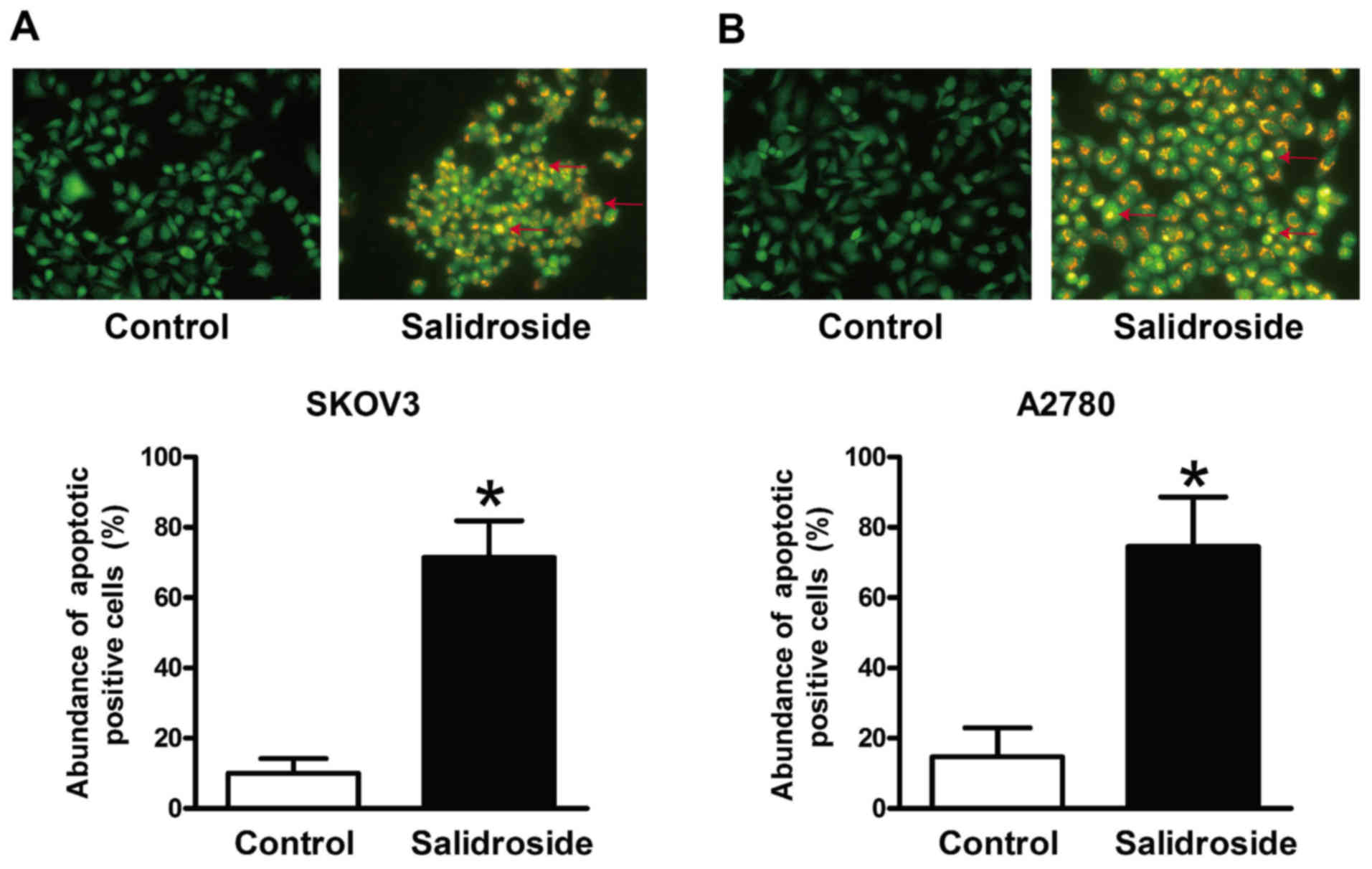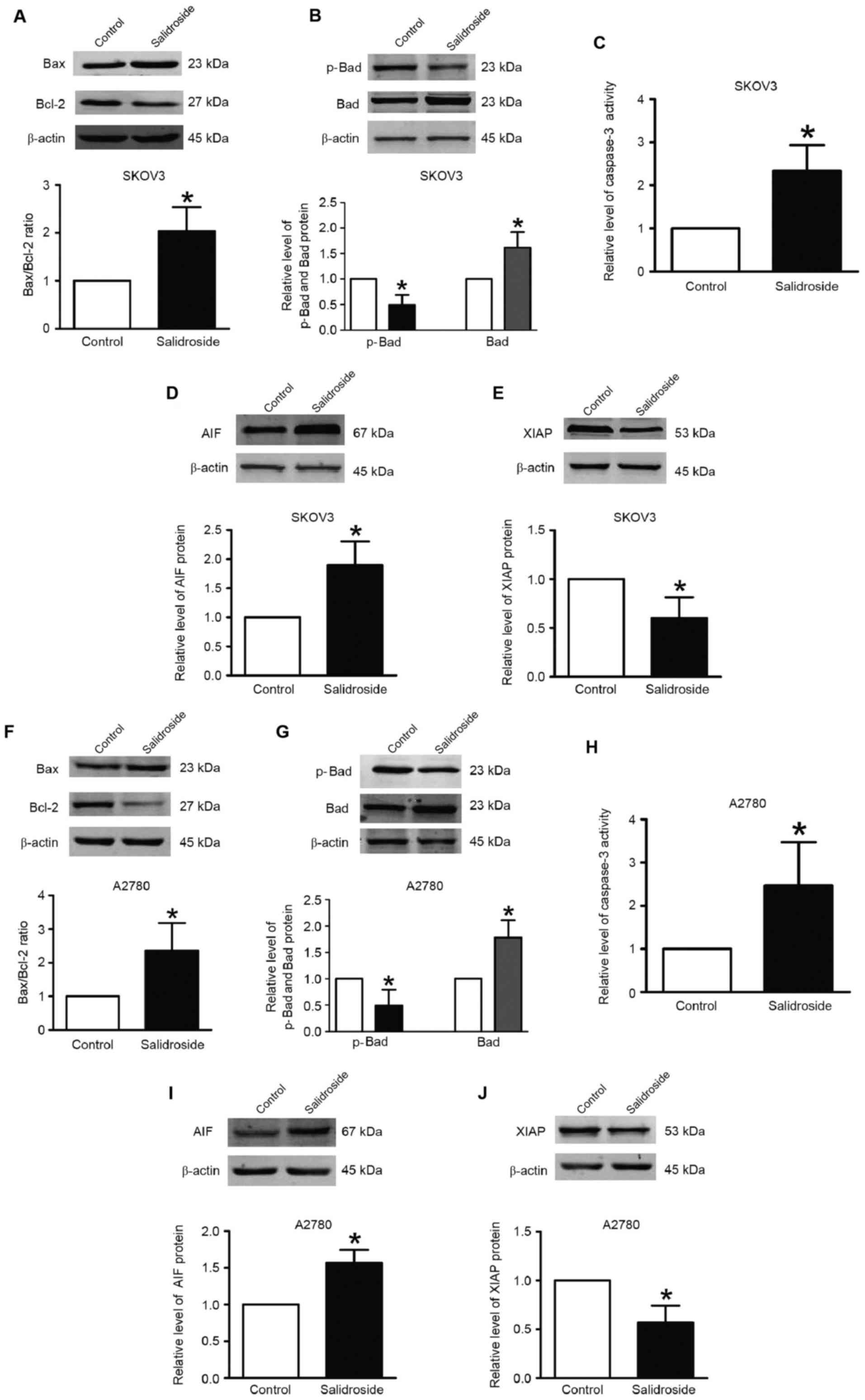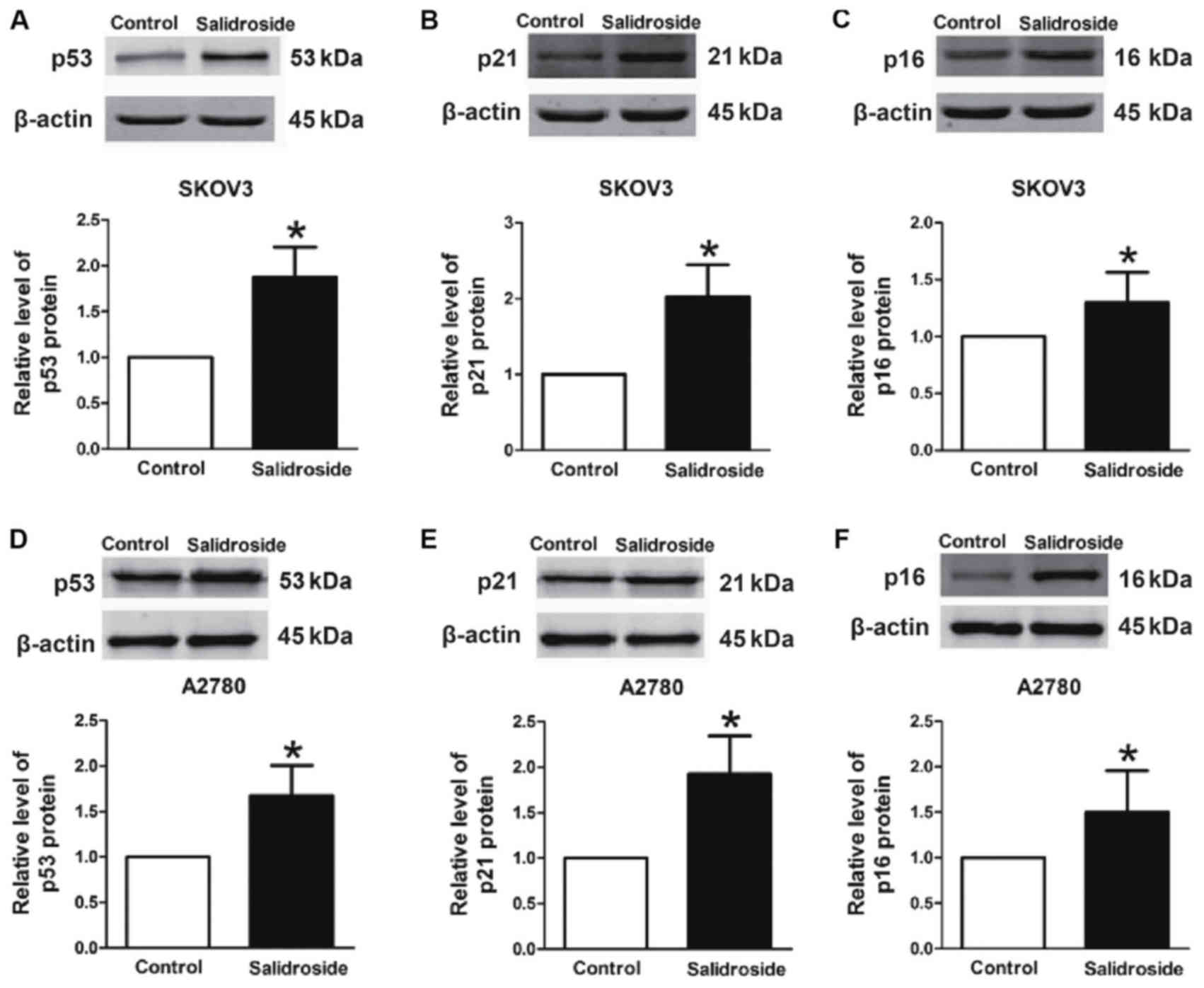|
1
|
Siegel R, Ma J, Zou Z and Jemal A: Cancer
statistics, 2014. CA Cancer J Clin. 64:9–29. 2014. View Article : Google Scholar : PubMed/NCBI
|
|
2
|
Vang R, Shih IeM and Kurman RJ: Ovarian
low-grade and high-grade serous carcinoma: Pathogenesis,
clinicopathologic and molecular biologic features, and diagnostic
problems. Adv Anat Pathol. 16:267–282. 2009. View Article : Google Scholar : PubMed/NCBI
|
|
3
|
Vaughan S, Coward JI, Bast RC Jr, Berchuck
A, Berek JS, Brenton JD, Coukos G, Crum CC, Drapkin R,
Etemadmoghadam D, et al: Rethinking ovarian cancer: Recommendations
for improving outcomes. Nat Rev Cancer. 11:719–725. 2011.
View Article : Google Scholar : PubMed/NCBI
|
|
4
|
Landen CN Jr, Birrer MJ and Sood AK: Early
events in the pathogenesis of epithelial ovarian cancer. J Clin
Oncol. 26:995–1005. 2008. View Article : Google Scholar : PubMed/NCBI
|
|
5
|
Friedlander M, Rau J, Lee CK, Meier W,
Lesoin A, Kim JW, Poveda A, Buck M, Scambia G, Shimada M, et al:
Quality of life in patients with advanced epithelial ovarian cancer
(EOC) randomized to maintenance pazopanib or placebo after
first-line chemotherapy in the AGO-OVAR 16 trial. Measuring what
matters-patient centered endpoints in trials of maintenance
therapy. Ann Oncol. Dec 18–2017.Doi: 10.1093/annonc/mdx796.
View Article : Google Scholar
|
|
6
|
Paik ES, Kim JH, Kim TJ, Lee JW, Kim BG,
Bae DS and Choi CH: Prognostic significance of normal-sized ovary
in advanced serous epithelial ovarian cancer. J Gynecol Oncol.
29:e132018. View Article : Google Scholar : PubMed/NCBI
|
|
7
|
Westin SN, Herzog TJ and Coleman RL:
Investigational agents in development for the treatment of ovarian
cancer. Invest New Drugs. 31:213–229. 2013. View Article : Google Scholar : PubMed/NCBI
|
|
8
|
Jin N, Wu H, Miao Z, Huang Y, Hu Y, Bi X,
Wu D, Qian K, Wang L, Wang C, et al: Network-based
survival-associated module biomarker and its crosstalk with cell
death genes in ovarian cancer. Sci Rep. 5:115662015. View Article : Google Scholar : PubMed/NCBI
|
|
9
|
Darbinyan V, Kteyan A, Panossian A,
Gabrielian E, Wikman G and Wagner H: Rhodiola rosea in stress
induced fatigue-a double blind cross-over study of a standardized
extract SHR-5 with a repeated low-dose regimen on the mental
performance of healthy physicians during night duty. Phytomedicine.
7:365–371. 2000. View Article : Google Scholar : PubMed/NCBI
|
|
10
|
Spasov AA, Wikman GK, Mandrikov VB,
Mironova IA and Neumoin VV: A double-blind, placebo-controlled
pilot study of the stimulating and adaptogenic effect of Rhodiola
rosea SHR-5 extract on the fatigue of students caused by stress
during an examination period with a repeated low-dose regimen.
Phytomedicine. 7:85–89. 2000. View Article : Google Scholar : PubMed/NCBI
|
|
11
|
Panossian A, Wikman G and Sarris J:
Rosenroot (Rhodiola rosea): Traditional use, chemical composition,
pharmacology and clinical efficacy. Phytomedicine. 17:481–493.
2010. View Article : Google Scholar : PubMed/NCBI
|
|
12
|
Mao GX, Xing WM, Wen XL, Jia BB, Yang ZX,
Wang YZ, Jin XQ, Wang GF and Yan J: Salidroside protects against
premature senescence induced by ultraviolet B irradiation in human
dermal fibroblasts. Int J Cosmet Sci. 37:321–328. 2015. View Article : Google Scholar : PubMed/NCBI
|
|
13
|
Barhwal K, Das SK, Kumar A, Hota SK and
Srivastava RB: Insulin receptor A and Sirtuin 1 synergistically
improve learning and spatial memory following chronic salidroside
treatment during hypoxia. J Neurochem. 135:332–346. 2015.
View Article : Google Scholar : PubMed/NCBI
|
|
14
|
Huang X, Zou L, Yu X, Chen M, Guo R, Cai
H, Yao D, Xu X, Chen Y, Ding C, et al: Salidroside attenuates
chronic hypoxia-induced pulmonary hypertension via adenosine A2a
receptor related mitochondria-dependent apoptosis pathway. J Mol
Cell Cardiol. 82:153–166. 2015. View Article : Google Scholar : PubMed/NCBI
|
|
15
|
Lai MC, Lin JG, Pai PY, Lai MH, Lin YM,
Yeh YL, Cheng SM, Liu YF, Huang CY and Lee SD: Protective effect of
salidroside on cardiac apoptosis in mice with chronic intermittent
hypoxia. Int J Cardiol. 174:565–573. 2014. View Article : Google Scholar : PubMed/NCBI
|
|
16
|
Zhao G, Shi A, Fan Z and Du Y: Salidroside
inhibits the growth of human breast cancer in vitro and in vivo.
Oncol Rep. 33:2553–2560. 2015. View Article : Google Scholar : PubMed/NCBI
|
|
17
|
Yang ZR, Wang HF, Zuo TC, Guan LL and Dai
N: Salidroside alleviates oxidative stress in the liver with
non-alcoholic steatohepatitis in rats. BMC Pharmacol Toxicol.
17:162016. View Article : Google Scholar : PubMed/NCBI
|
|
18
|
McGahon AJ, Martin SJ, Bissonnette RP,
Mahboubi A, Shi Y, Mogil RJ, Nishioka WK and Green DR: The end of
the (cell) line: Methods for the study of apoptosis in vitro.
Methods Cell Biol. 46:153–185. 1995. View Article : Google Scholar : PubMed/NCBI
|
|
19
|
Chen H, Takahashi S, Imamura M, Okutani E,
Zhang ZG, Chayama K and Chen BA: Earthworm fibrinolytic enzyme:
Anti-tumor activity on human hepatoma cells in vitro and in vivo.
Chin Med J (Engl). 120:898–904. 2007.PubMed/NCBI
|
|
20
|
Ribble D, Goldstein NB, Norris DA and
Shellman YG: A simple technique for quantifying apoptosis in
96-well plates. BMC Biotechnol. 5:122005. View Article : Google Scholar : PubMed/NCBI
|
|
21
|
Lambert KE, Huang H, Mythreye K and Blobe
GC: The type III transforming growth factor-beta receptor inhibits
proliferation, migration, and adhesion in human myeloma cells. Mol
Biol Cell. 22:1463–1472. 2011. View Article : Google Scholar : PubMed/NCBI
|
|
22
|
Lv C, Huang Y, Liu ZX, Yu D and Bai ZM:
Salidroside reduces renal cell carcinoma proliferation by
inhibiting JAK2/STAT3 signaling. Cancer Biomark. 17:41–47. 2016.
View Article : Google Scholar : PubMed/NCBI
|
|
23
|
Hu X, Lin S, Yu D, Qiu S, Zhang X and Mei
R: A preliminary study: The anti-proliferation effect of
salidroside on different human cancer cell lines. Cell Biol
Toxicol. 26:499–507. 2010. View Article : Google Scholar : PubMed/NCBI
|
|
24
|
Sun C, Wang Z, Zheng Q and Zhang H:
Salidroside inhibits migration and invasion of human fibrosarcoma
HT1080 cells. Phytomedicine. 19:355–363. 2012. View Article : Google Scholar : PubMed/NCBI
|
|
25
|
Zhang L, Yu H, Sun Y, Lin X, Chen B, Tan
C, Cao G and Wang Z: Protective effects of salidroside on hydrogen
peroxide-induced apoptosis in SH-SY5Y human neuroblastoma cells.
Eur J Pharmacol. 564:18–25. 2007. View Article : Google Scholar : PubMed/NCBI
|
|
26
|
Liu Z, Li X, Simoneau AR, Jafari M and Zi
X: Rhodiola rosea extracts and salidroside decrease the growth of
bladder cancer cell lines via inhibition of the mTOR pathway and
induction of autophagy. Mol Carcinog. 51:257–267. 2012. View Article : Google Scholar : PubMed/NCBI
|
|
27
|
Li X, Su J, Xia M, Li H, Xu Y, Ma C, Ma L,
Kang J, Yu H, Zhang Z and Sun L: Caspase-mediated cleavage of
Beclin1 inhibits autophagy and promotes apoptosis induced by S1 in
human ovarian cancer SKOV3 cells. Apoptosis. 21:225–238. 2016.
View Article : Google Scholar : PubMed/NCBI
|
|
28
|
Zhang C and Qiu X: Andrographolide
radiosensitizes human ovarian cancer SKOV3 xenografts due to an
enhanced apoptosis and autophagy. Tumour Biol. 36:8359–8365. 2015.
View Article : Google Scholar : PubMed/NCBI
|
|
29
|
Zhan Y, Xiang F, Wu R, Xu J, Ni Z, Jiang J
and Kang X: MiRNA-149 modulates chemosensitivity of ovarian cancer
A2780 cells to paclitaxel by targeting MyD88. J Ovarian Res.
8:482015. View Article : Google Scholar : PubMed/NCBI
|
|
30
|
Huang C, Gu H, Zhang W, Herrmann JL and
Wang M: Testosterone-down-regulated Akt pathway during cardiac
ischemia/reperfusion: A mechanism involving BAD, Bcl-2 and FOXO3a.
J Surg Res. 164:e1–e11. 2010. View Article : Google Scholar : PubMed/NCBI
|
|
31
|
Paulsen M, Ussat S, Jakob M, Scherer G,
Lepenies I, Schütze S, Kabelitz D and Adam-Klages S: Interaction
with XIAP prevents full caspase-3/-7 activation in proliferating
human T lymphocytes. Eur J Immunol. 38:1979–1987. 2008. View Article : Google Scholar : PubMed/NCBI
|
|
32
|
Xie Y, Tobin LA, Camps J, Wangsa D, Yang
J, Rao M, Witasp E, Awad KS, Yoo N, Ried T and Kwong KF:
MicroRNA-24 regulates XIAP to reduce the apoptosis threshold in
cancer cells. Oncogene. 32:2442–2451. 2013. View Article : Google Scholar : PubMed/NCBI
|
|
33
|
Ikenberg K, Valtcheva N, Brandt S, Zhong
Q, Wong CE, Noske A, Rechsteiner M, Rueschoff JH, Caduff R, Dellas
A, et al: KPNA2 is overexpressed in human and mouse endometrial
cancers and promotes cellular proliferation. J Pathol. 234:239–252.
2014.PubMed/NCBI
|
|
34
|
Li YD, Hong YF, Yusufuaji Y, Tang BP, Zhou
XH, Xu GJ, Li JX, Sun L, Zhang JH, Xin Q, et al: Altered expression
of hyperpolarization-activated cyclic nucleotide-gated channels and
microRNA-1 and −133 in patients with age-associated atrial
fibrillation. Mol Med Rep. 12:3243–3248. 2015. View Article : Google Scholar : PubMed/NCBI
|
|
35
|
Gu J, Tang Y, Liu Y, Guo H, Wang Y, Cai L,
Li Y and Wang B: Murine double minute 2 siRNA and wild-type p53
gene therapy enhances sensitivity of the SKOV3/DDP ovarian cancer
cell line to cisplatin chemotherapy in vitro and in vivo. Cancer
Lett. 343:200–209. 2014. View Article : Google Scholar : PubMed/NCBI
|
|
36
|
Gherman C, Braicu OL, Zanoaga O, Jurj A,
Pileczki V, Maralani M, Drigla F, Braicu C, Budisan L,
Achimas-Cadariu P and Berindan-Neagoe I: Caffeic acid phenethyl
ester activates pro-apoptotic and epithelial-mesenchymal
transition-related genes in ovarian cancer cells A2780 and
A2780cis. Mol Cell Biochem. 413:189–198. 2016. View Article : Google Scholar : PubMed/NCBI
|













